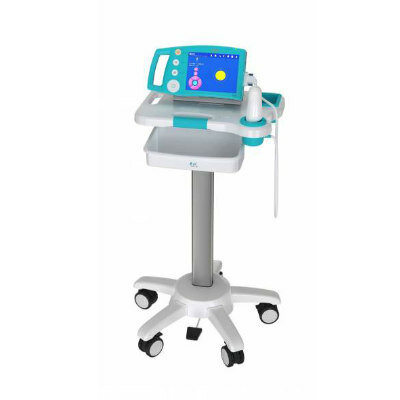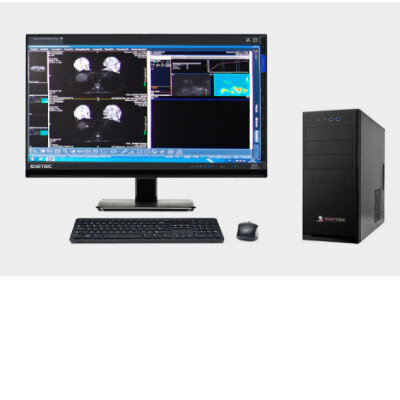Focused Ultrasound Technique Gets Quality Assurance Protocol
|
By MedImaging International staff writers Posted on 08 Apr 2024 |

In recent years, researchers have harnessed the potential of focused ultrasound (FUS) in combination with microbubbles to temporarily open the blood-brain barrier (BBB), a method that significantly enhances the delivery of therapeutic agents directly to brain tissues or facilitates the extraction of biomarkers for various brain conditions. This innovative approach employs ultrasonic energy to precisely target brain areas requiring treatment or analysis. Following the identification of the target area, microbubbles are introduced into the bloodstream, traveling to the site and creating minute openings in the BBB as they burst. This process allows for the bidirectional transfer of drugs into the brain or biomarkers from a tumor or other brain diseases into the bloodstream. Despite the rapid advancement of this technology, ensuring its safe and consistent application has presented challenges.
After years of developing the noninvasive technique, researchers at Washington University in St. Louis (WUSTL, St. Louis, MO, USA) have now developed a quality assurance protocol to ensure safe treatment and consistent functioning of their guided focused ultrasound device. This quality assurance strategy involves integrating an acoustic sensor with the FUS device to perform three critical quality assurance checks: verifying the device functions consistently, ensuring that acoustic coupling, or a gel that allows the signals to transmit from the body to the transducer, can detect air bubbles trapped in the transducer, and confirming the consistency of the treatment process. The researchers found that their passive acoustic detection protocol can be integrated with a clinical FUS system for the procedure’s quality assurance.
During their clinical trial involving 10 patients, the quality assurance measures were largely successful with the FUS device meeting quality assurance standards in nine cases. However, when assessing acoustic coupling, initial tests indicated failures in four out of nine instances due to air bubbles in the ultrasound probe or gel, which could potentially reflect ultrasound waves, reducing the energy reaching the brain. These issues were addressed until the coupling passed quality assurance in most cases. The protocol also evaluated the treatment's consistency by monitoring the pattern of microbubble cavitation, which should show a rapid increase in activity followed by a return to baseline. This quality assurance approach demonstrates the feasibility of integrating passive acoustic detection with clinical FUS systems, ensuring the safety and reliability of this cutting-edge technology.
“Without a systematic and quantifiable approach to evaluate FUS devices before each procedure, the functionality of the FUS system cannot be guaranteed,” said doctoral student Chih-Yen Chien. “Our study is the first to evaluate passive acoustic detection-based quality assurance for FUS systems with applications that can be extended beyond BBB opening to include other applications, such as ultrasound neuromodulation.”
Related Links:
Washington University in St. Louis
Latest Ultrasound News
- Deep Learning Advances Super-Resolution Ultrasound Imaging
- Novel Ultrasound-Launched Targeted Nanoparticle Eliminates Biofilm and Bacterial Infection
- AI-Guided Ultrasound System Enables Rapid Assessments of DVT
- AI-Guided Handheld Ultrasound System Helps Capture Diagnostic-Quality Cardiac Images
- Non-Invasive Ultrasound Imaging Device Diagnoses Risk of Chronic Kidney Disease
- Wearable Ultrasound Platform Paves Way for 24/7 Blood Pressure Monitoring On the Wrist
- Diagnostic Ultrasound Enhancing Agent to Improve Image Quality in Pediatric Heart Patients
- AI Detects COVID-19 in Lung Ultrasound Images
- New Ultrasound Technology to Revolutionize Respiratory Disease Diagnoses
- Dynamic Contrast-Enhanced Ultrasound Highly Useful For Interventions
- Ultrasensitive Broadband Transparent Ultrasound Transducer Enhances Medical Diagnosis
- Artificial Intelligence Detects Heart Defects in Newborns from Ultrasound Images
- Ultrasound Imaging Technology Allows Doctors to Watch Spinal Cord Activity during Surgery

- Shape-Shifting Ultrasound Stickers Detect Post-Surgical Complications
- Non-Invasive Ultrasound Technique Helps Identify Life-Changing Complications after Neck Surgery
- Remote Ultrasound Platform Offers Diagnostic Scans from Anywhere
Channels
Radiography
view channel
Novel Breast Imaging System Proves As Effective As Mammography
Breast cancer remains the most frequently diagnosed cancer among women. It is projected that one in eight women will be diagnosed with breast cancer during her lifetime, and one in 42 women who turn 50... Read more
AI Assistance Improves Breast-Cancer Screening by Reducing False Positives
Radiologists typically detect one case of cancer for every 200 mammograms reviewed. However, these evaluations often result in false positives, leading to unnecessary patient recalls for additional testing,... Read moreMRI
view channel
PET/MRI Improves Diagnostic Accuracy for Prostate Cancer Patients
The Prostate Imaging Reporting and Data System (PI-RADS) is a five-point scale to assess potential prostate cancer in MR images. PI-RADS category 3 which offers an unclear suggestion of clinically significant... Read more
Next Generation MR-Guided Focused Ultrasound Ushers In Future of Incisionless Neurosurgery
Essential tremor, often called familial, idiopathic, or benign tremor, leads to uncontrollable shaking that significantly affects a person’s life. When traditional medications do not alleviate symptoms,... Read more
Two-Part MRI Scan Detects Prostate Cancer More Quickly without Compromising Diagnostic Quality
Prostate cancer ranks as the most prevalent cancer among men. Over the last decade, the introduction of MRI scans has significantly transformed the diagnosis process, marking the most substantial advancement... Read moreNuclear Medicine
view channel
New SPECT/CT Technique Could Change Imaging Practices and Increase Patient Access
The development of lead-212 (212Pb)-PSMA–based targeted alpha therapy (TAT) is garnering significant interest in treating patients with metastatic castration-resistant prostate cancer. The imaging of 212Pb,... Read moreNew Radiotheranostic System Detects and Treats Ovarian Cancer Noninvasively
Ovarian cancer is the most lethal gynecological cancer, with less than a 30% five-year survival rate for those diagnosed in late stages. Despite surgery and platinum-based chemotherapy being the standard... Read more
AI System Automatically and Reliably Detects Cardiac Amyloidosis Using Scintigraphy Imaging
Cardiac amyloidosis, a condition characterized by the buildup of abnormal protein deposits (amyloids) in the heart muscle, severely affects heart function and can lead to heart failure or death without... Read moreGeneral/Advanced Imaging
view channel
New AI Method Captures Uncertainty in Medical Images
In the field of biomedicine, segmentation is the process of annotating pixels from an important structure in medical images, such as organs or cells. Artificial Intelligence (AI) models are utilized to... Read more.jpg)
CT Coronary Angiography Reduces Need for Invasive Tests to Diagnose Coronary Artery Disease
Coronary artery disease (CAD), one of the leading causes of death worldwide, involves the narrowing of coronary arteries due to atherosclerosis, resulting in insufficient blood flow to the heart muscle.... Read more
Novel Blood Test Could Reduce Need for PET Imaging of Patients with Alzheimer’s
Alzheimer's disease (AD), a condition marked by cognitive decline and the presence of beta-amyloid (Aβ) plaques and neurofibrillary tangles in the brain, poses diagnostic challenges. Amyloid positron emission... Read more.jpg)
CT-Based Deep Learning Algorithm Accurately Differentiates Benign From Malignant Vertebral Fractures
The rise in the aging population is expected to result in a corresponding increase in the prevalence of vertebral fractures which can cause back pain or neurologic compromise, leading to impaired function... Read moreImaging IT
view channel
New Google Cloud Medical Imaging Suite Makes Imaging Healthcare Data More Accessible
Medical imaging is a critical tool used to diagnose patients, and there are billions of medical images scanned globally each year. Imaging data accounts for about 90% of all healthcare data1 and, until... Read more
Global AI in Medical Diagnostics Market to Be Driven by Demand for Image Recognition in Radiology
The global artificial intelligence (AI) in medical diagnostics market is expanding with early disease detection being one of its key applications and image recognition becoming a compelling consumer proposition... Read moreIndustry News
view channel
Bayer and Google Partner on New AI Product for Radiologists
Medical imaging data comprises around 90% of all healthcare data, and it is a highly complex and rich clinical data modality and serves as a vital tool for diagnosing patients. Each year, billions of medical... Read more



















